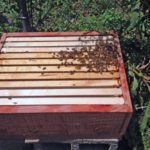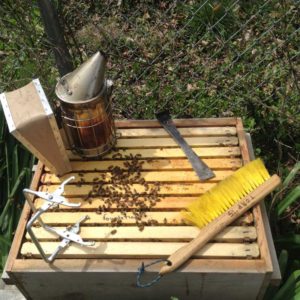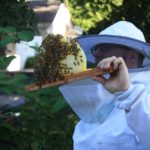The Amos Farm
Keeping Bees – Part One
by Christian Torp
“‘The bottom line is, if something is not done to improve honeybee health, then most of the interesting food we eat is going to be unavailable,’ warns Carlen Jupe, secretary and treasurer for the California State Beekeepers Association.”
“What Our World Would Look Like Without Honeybees” by Dina Spector, Business Insider, 6-22-13
First Step: Get Registered
We have two quotes this week: “Anyone who keeps honeybees in Maine MUST obtain an apiary license,” Maine Department of Agriculture, Conservation and Forestry.
Don’t worry, it’s only $2 for 1-5 hives and $5 for 6-10.
With that out of the way, let’s get to it.
Have you been captivated by the zen of beekeeping since childhood? Or are you a potential convert to the bliss that is sticking your hand into a box of 60,000 stinging insects? Are you looking to bring in gallons of amber gold, or would you rather spend hundreds of dollars on equipment and lose hundreds more in dead-outs, absconding bees and/or swarming? If you fall somewhere on that spectrum, you’ve come to the right place! But the best reason to keep bees is because you want to. Nothing more.
When you think “beehive” what do you picture? A stack of rectangular painted boxes somewhere in a field (langstroth hives) or perhaps an illustration of a skep with bees buzzing about it?
Humans have kept bees since at least 2422 BC. This is the date of the Egyptian sun temple Nyuserre Ini which depicts workers blowing smoke into their hives. But there have been some changes in hive technology since those days. Today, modern hives feature removable frames and, depending on hive type, standardization and mass production of parts or whole hives.
The biggest decision you’re going to make when you decide to get into beekeeping is the type of hives you’ll keep. And yes, that’s hives with an “s.” It’s recommended that you begin with at least two so that you’ll have a comparison and can manipulate resources should it become necessary.
Next: Choose a Hive Type
As for hive types, the saying goes, “If you ask ten different beekeepers you’ll get eleven different answers.”
Indeed, many beekeepers have real prejudices against some hive types, so don’t listen to any one person. Ask many, look into a local beekeeping group and do what seems most appealing to you.
We will get stuck on hive types next month, but there are the Langstroth (the standard square boxes, easy to get parts and advice for, highest honey production, requires heavy lifting), the top bar (easiest to make, requires inspection at least twice a week during the season, bees make their own comb, fragile), and the Warre (a vertical top bar, requires minimal interaction, potentially most natural way to keep bees).
Next: Here’s what you’ll need apart from the hive.
You don’t need to buy a beekeeping kit or anything of the sort to get started in beekeeping. But there is one thing which I HIGHLY DISSUADE you from foregoing. That thing is a veil.
Otherwise, you’ll probably want:
Hive
Bees
Veil
Hive tool
Smoker
Feeder
DO NOT WORK YOUR BEES WITHOUT WEARING YOU VEIL. Bees are attracted to your exhalation and can sting your eyes and inside your mouth. You’re gonna get stung, wear your veil.
I’ve also learned not to work my bees in the evenings, especially early or late in the season’s when it becomes so cool, so quickly as the sun sets as bees will have congregated somewhere they can’t return to the hive from in the cool.
Finally: Is it worth it?
As I’ve repeatedly refrained, do what you want to do, don’t do what you don’t. If it’s a joy to you then it’s worth the time and money, if it isn’t, it’s not. Don’t believe the hype about all the honey you’ll have, don’t believe it for a minute. If the enticement is the money you’ll make, stop reading. You may have a tremendous harvest or you may invest multiple years into multiple hives only to come out with a lighter wallet and no heavier a honey pot. There are no failures, there’s only information; what’s the information worth to you? Come back to the Amos Farm next month for more information, and good luck (when you get stung remove the stinger by scraping your skin with your hive tool, don’t try to pinch the stinger out.)
RESOURCES
Maine State Beekeepers Association: http://mainebeekeepers.org/
The Honey Exchange, 494 Stevens Avenue, Portland, ME 04103: https://thehoneyexchange.com
Mother Earth News on hive types: http://www.motherearthnews.com/homesteading-and-livestock/langstroth-top-bar-or-warre-zbcz1310
Registering bees: http://www.maine.gov/DACF/php/apiary/documents/2017ApiaryApplication.pdf
Christian L. Torp
Christian is an attorney, missionary, activist, urban-farmer, foster parent and advocate for social change who lives at Justice House (facebook: Justice House) with his wife, Tanya in Lexington, KY.
If you have any questions or comments for Christian, or there’s something you’d like to know more about, please reach out to him at theamosfarm@gmail.com.








